|
|
|
Sort Order |
|
|
|
Items / Page
|
|
|
|
|
|
|
| Srl | Item |
| 1 |
ID:
166537


|
|
|
|
|
| Summary/Abstract |
Global warming is one of the issues of great concern in the world. The large-scale use of fossil fuels has led to the continuous increase in carbon emissions, resulting in global energy shortages and environmental pollution. Reasonable and strict environmental regulation promotes technological innovation by enterprises to achieve a win-win situation between the economy and environment, which is the core idea of the Porter hypothesis. The choice of China, as the world's largest energy consumer and carbon emitter, is not only related to the country's own mode of economic growth but also determines the development of the world's low-carbon economy. We used the panel data from 2000 to 2016 of 30 provincial-level administrative regions in China and adopted the Propensity Score Matching–Difference in Differences method to test the impact of China's carbon trading pilot system on the transformation of a low-carbon economy. The empirical results show that under the constraints of the established resources and environment, there is a positive relationship to some extent between China's carbon trading system and low-carbon economic transformation. This relationship can realize the win-win situation of environmental and economic benefits as advocated by the Porter hypothesis and further verify the applicability of the Porter hypothesis.
|
|
|
|
|
|
|
|
|
|
|
|
|
|
|
|
| 2 |
ID:
166307
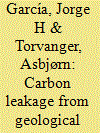

|
|
|
|
|
| Summary/Abstract |
A number of studies show that large-scale deployment of Carbon Capture and Storage (CCS) is necessary to limit the increase in global average temperature to less than 2 °C by 2100. However, some experts and citizens worry about the integrity of carbon dioxide storage sites due to the possibility of future leakage. We introduce a two-period model where two emission mitigation technologies are available to society in the first period: CCS, with a risk of carbon dioxide leakage in the second period, and a riskless mitigation alternative, such as renewable energy. We first solve the model assuming that society does not know what the future rate of leakage will be. We then solve the model assuming that society will eventually learn the actual leakage rate. We find that, in a trading market in period one, reductions of CO2 emissions through CCS should generate a less than proportional amount of CO2 allowances. Estimates from simulations, using a coarse range of parameters, indicate that the discount factor of CCS allowances lies in the range (0.72, 1). Site-specific data is required to determine site-specific risks of leakage and discount factors.
|
|
|
|
|
|
|
|
|
|
|
|
|
|
|
|
| 3 |
ID:
109636
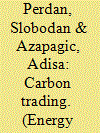

|
|
|
|
|
| Publication |
2011.
|
| Summary/Abstract |
This paper looks at the greenhouse gas (GHG) emissions trading schemes and examines the prospects of carbon trading. The first part of the paper gives an overview of several mandatory GHG trading schemes around the world. The second part focuses on the future trends in carbon trading. It argues that the emergence of new schemes, a gradual enlargement of the current ones, and willingness to link existing and planned schemes seem to point towards geographical, temporal and sectoral expansion of emissions trading. However, such expansion would need to overcome some considerable technical and non-technical obstacles. Linking of the current and emerging trading schemes requires not only considerable technical fixes and harmonisation of different trading systems, but also necessitates clear regulatory and policy signals, continuing political support and a more stable economic environment. Currently, the latter factors are missing. The global economic turmoil and its repercussions for the carbon market, a lack of the international deal on climate change defining the Post-Kyoto commitments, and unfavourable policy shifts in some countries, cast serious doubts on the expansion of emissions trading and indicate that carbon trading enters an uncertain period.
|
|
|
|
|
|
|
|
|
|
|
|
|
|
|
|
| 4 |
ID:
149890
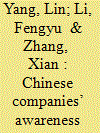

|
|
|
|
|
| Summary/Abstract |
China announced the launch of a national Emissions Trading Scheme (ETS) in 2017; however, companies appear show little enthusiasm for participation in the ETS in China. This paper identifies the factors affecting companies’ awareness and perceptions of ETS by conducting a national survey based on an online questionnaire from May to November 2015 in seven carbon trading pilots. The results indicate that companies’ attitudes towards the ETS are positively influenced by government regulations and policy, public relations management and estimated economic benefit. Of these, public relations management is the decisive factor and estimated economic benefit is confirmed to be a relatively weak predictor. A company's environmental and energy strategy exerts insignificant effects on its preference for the ETS, although the sampled companies are very willing to save energy and reduce emissions. There exists an inverted U-shape relationship between a company's level of mitigation technologies and its attitudes towards the ETS. The carbon price fails to stimulate companies to upgrade mitigation technologies. The majority of companies treat participation in the ETS only as a means of improving ties with governments, as well as of earning a good social reputation, rather than as a cost-effective mechanism to mitigate greenhouse gas emissions.
|
|
|
|
|
|
|
|
|
|
|
|
|
|
|
|
| 5 |
ID:
097338


|
|
|
|
|
| Publication |
2010.
|
| Summary/Abstract |
This paper analyses the design of carbon markets in space (i.e., geographically). It is part of a twin set of papers that, starting from first principles, ask what an optimal global carbon market would look like by around 2030. Our focus is on firm-level cap-and-trade systems, although much of what we say would also apply to government-level trading and carbon offset schemes. We examine the "first principles" of spatial design to maximise flexibility and to minimise costs, including key design issues in linking national and regional carbon markets together to create a global carbon market.
|
|
|
|
|
|
|
|
|
|
|
|
|
|
|
|
| 6 |
ID:
097333


|
|
|
|
|
| Publication |
2010.
|
| Summary/Abstract |
This paper analyses the design of carbon markets in time (i.e., intertemporally). It is part of a twin set of papers that ask, starting from first principles, what an optimal global carbon market would look like by around 2030. Our focus is on firm-level cap-and-trade systems, although much of what we say would also apply to government-level trading and carbon offset schemes. We examine the "first principles" of temporal design that would help to maximise flexibility and to minimise costs, including banking and borrowing and other mechanisms to provide greater carbon price predictability and credibility over time.
|
|
|
|
|
|
|
|
|
|
|
|
|
|
|
|
| 7 |
ID:
132685
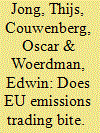

|
|
|
|
|
| Publication |
2014.
|
| Summary/Abstract |
The aim of this paper is to examine whether shareholders consider the EU Emissions Trading Scheme (EU ETS) as value-relevant for the participating firms. An analysis is conducted of the share prices changes as caused by the first publication of compliance data in April, 2006, which disclosed an over-allocation of emission allowances. Through an event study, it is shown that share prices actually increased as a result of the allowance price drop when firms have a lower carbon-intensity of production and larger allowance holdings. There was no significant value impact from firms× allowance trade activity or from the pass-through of carbon-related production costs (carbon leakage). The conclusion is that the EU ETS does 'bite'. The main impact on the share prices of firms arises from their carbon-intensity of production. The EU ETS is thus valued as a restriction on pollution.
|
|
|
|
|
|
|
|
|
|
|
|
|
|
|
|
| 8 |
ID:
138262
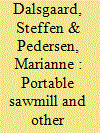

|
|
|
|
|
| Summary/Abstract |
The future for Reducing Emissions from Deforestation and Forest Degradation Plus (REDD+) in Papua New Guinea (PNG) is uncertain. Logging companies have been accessing land via a controversial legal framework called Special Agricultural Business Lease, while conservation non-government organisations are struggling to find schemes to stop the deforestation. REDD+ has been the new favoured approach. However, there are as yet only a few pilot projects, several of which are in areas without large-scale logging. Whether REDD+ has a future in PNG is difficult to know. It may come to share the fate of the portable sawmill – a technology previously assumed to promote sustainable community logging, but is now adopted by the commercial logging industry and providing new challenges to conversation efforts. This article argues that to understand the possibility for successfully implementing REDD+, it is necessary to look at the development of the forestry sector in the widest possible terms. This involves analysing the different competing actors, technologies and forms of social organisation that are employed to gain control of species deemed valuable to either conservation or commercial resource exploitation.
|
|
|
|
|
|
|
|
|
|
|
|
|
|
|
|
| 9 |
ID:
138263
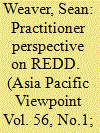

|
|
|
|
|
| Summary/Abstract |
This paper presents a practitioner perspective on community-based REDD (Reducing Emissions from Deforestation and forest Degradation) projects in the Pacific Islands. It draws upon the author's experience in forest conservation financing since 1987, and REDD project and programme design, development and implementation since 2006. The aim is to highlight the commercial challenges faced by REDD practitioners, and explore strategic (including policy) solutions to meet these challenges. The paper begins by situating REDD as a tool for forest conservation and community development. Following a brief overview of the key elements of REDD project development procedures, the paper examines commercial (particularly market access) challenges faced by project proponents, together with challenges associated with the supply and demand dynamic for REDD credits in the global carbon market. This is situated against a backdrop of global policy stagnation in the REDD sector and the implications of this for those at the frontier of community-based forest protection efforts on the ground. The paper culminates by showing the importance of an effective partnership between governments, rainforest communities and the private sector in regional and global rainforest conservation financing.
|
|
|
|
|
|
|
|
|
|
|
|
|
|
|
|
|
|
|
|
|